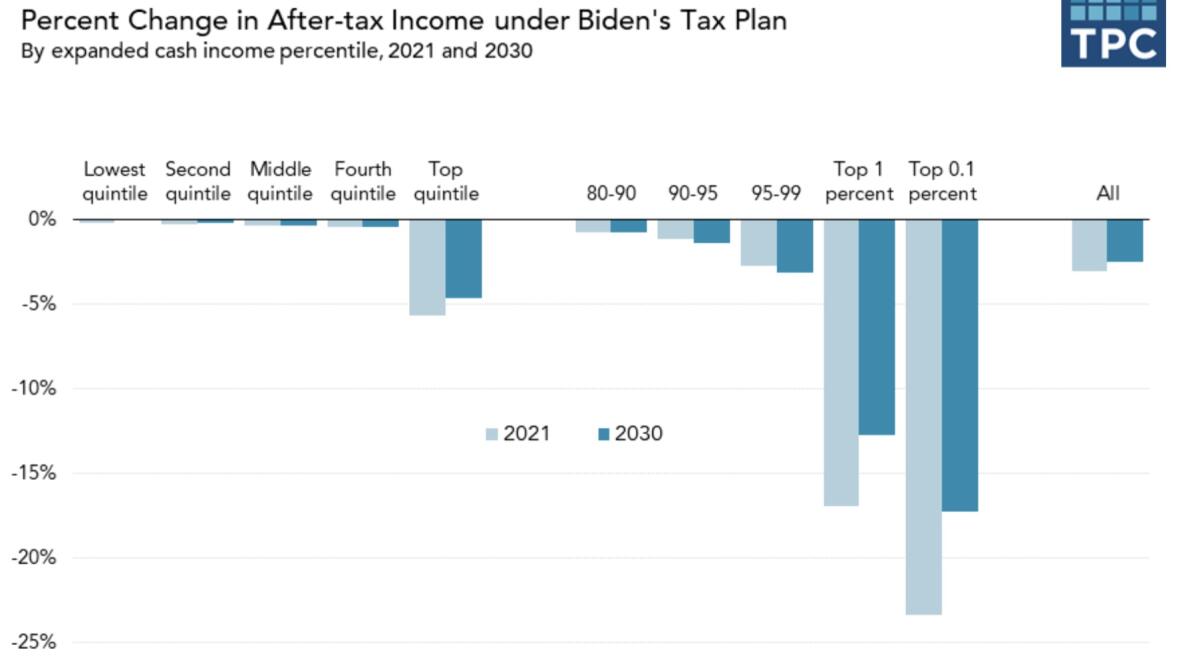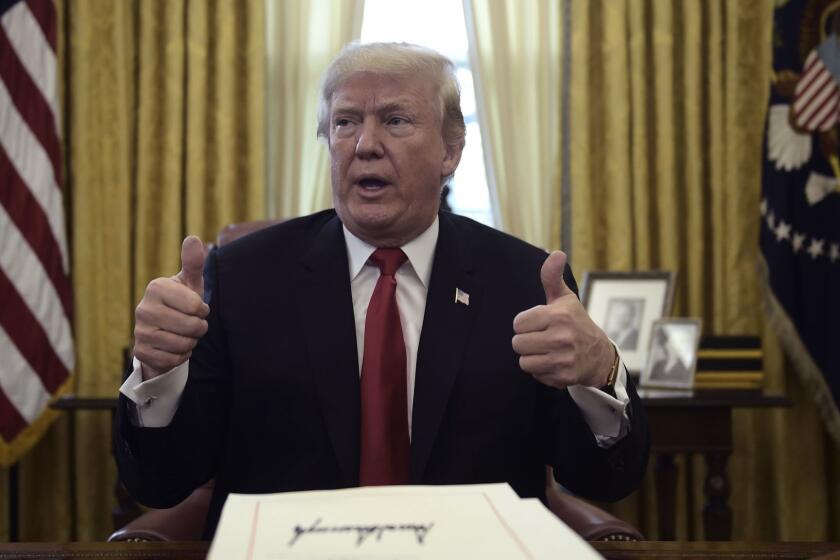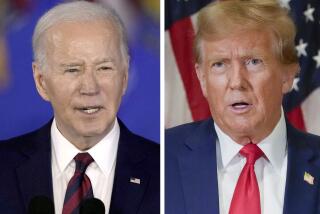Column: Bidenomics vs. MAGAnomics — which is better for the economy, and you?

Those who say that next month’s presidential election could be the most consequential in most Americans’ lifetimes may be understating the case: The glaring differences between Democrat Joe Biden and Republican Donald Trump go beyond politics and infuse their economic approaches, too.
It’s timely, therefore, to take a close look at the candidates’ economic platforms — call them Bidenomics and MAGAnomics.
Making direct comparisons are a bit difficult, because Biden has set forth detailed proposals on taxation and government spending, while Trump has merely posted a bullet-pointed list of aspirational goals — “Create 10 million new jobs,” “Cut prescription drug prices” and so on — without specifying how he would achieve them.
A large increase in fiscal spending, funded in part by increased tax revenue, would boost economic growth and help offset the earnings headwind from higher tax rates.
— Goldman Sachs analysis of Joe Biden’s economic plan
Moody’s Analytics put the issue squarely in a Sept. 23 paper. Judging Trump’s policies is “complicated,” the firm said, “by their lack of transparency and specificity.”
That said, Moody’s came to a conclusion similar to those of economic think tanks all along the political spectrum: Biden’s policies will spur greater economic growth and a more fair distribution of those gains than Trump’s.
Many investment analysts appear to agree. Goldman Sachs economists foresee “a modestly positive net impact” on corporate earnings from a Democratic sweep — that is, a Biden win, takeover of the Senate, and hold of the House.
“A large increase in fiscal spending, funded in part by increased tax revenue, would boost economic growth and help offset the earnings headwind from higher tax rates,” the firm said.
Contrary to Trump’s claims, history shows the economy and stock market do better under Democrats than Republicans
The stock market may be telegraphing the same expectation. In the week ended Oct. 9, the benchmark Standard & Poor’s 500 index recorded its strongest performance since August.
It’s unclear whether the surge reflected relief that Biden’s widening advantage over Trump in opinion polls presages the reduced prospect of an uncertain election day result, or anticipation of a stimulative economic policy.
Biden and Trump differ on both sides of the economic ledger. Biden’s proposals pencil out to $7.3 trillion in new spending over the next decade, according to a reckoning by Moody’s. Most of that spending would come in his first term and be concentrated on infrastructure and social programs, including healthcare and low-income assistance.
Trump’s plan anticipates a reduction in federal nondefense spending of $740 billion. Moody’s is also concerned about a continuation, if not intensification, of Trump’s campaign against immigration and a continuation of his trade wars with China and even longstanding allies.

During Trump’s first term, the overall increase in tariffs to a peak of 6% from 1.5% “acted like a tax increase on the U.S. economy, hurting U.S. manufacturers, transportation companies, and farmers in particular,” Moody’s wrote. “More of the same is expected in Trump’s second term.”
Expectations are that Biden would roll back restrictions on immigration, which would increase the U.S. labor force, and end the trade wars. Many analysts suggest that the latter, in particular, would remove the tariff-driven drag on the economy and restore stability to trade relations.
One economic circumstance that hasn’t featured heavily in analyses of the two candidates’ platforms thus far is the COVID-19 pandemic. In part that’s because the course and cost of the pandemic remain imponderable, although a recent estimate places its impact on the U.S. economy at a stunning $16 trillion, or almost as much as a year’s gross domestic product.
But much of that estimate arises from the Trump administration’s failure to address the pandemic effectively; Biden has laid out a plan to take a firmer hand on social measures, better coordination of government activities and a more consistent approach to the science of the virus, treatments and vaccines.
Trump’s economic vision looks to a long-gone America; Biden’s to the next stage.
In one area the candidates are similar: Both would increase the federal debt significantly, according to the Committee for a Responsible Federal Budget, an anti-deficit think tank. The committee forecasts that the federal debt would increase from 98% of GDP today to 125% by 2030 under Trump and to 128% under Biden. The estimates don’t incorporate coronavirus relief spending.
Biden’s program would increase federal spending well beyond any tax increases he has proposed; Trump’s would expand the deficit by cutting tax revenues lower than what’s needed to fund the government.
Biden has endorsed raising taxes on wealthier Americans, starting with households with income of more than $400,000 a year, and restoring some of the corporate tax cuts enacted by Republicans in 2017. The $400,000 threshold would cover the top 1.8% of American households. Biden also would impose the payroll tax, which funds Social Security and part of Medicare, on the same segment; currently the payroll tax is capped at wage income of $137,700, which will rise to $142,800 next year.
Biden’s plan would concentrate the income and payroll tax among the 1%, a level that starts at income of about $700,000 a year. They would shoulder 96.7% of his tax changes, according to the Penn-Wharton Budget Model.
Biden would increase the top marginal corporate tax rate to 28%, partially rolling back the reduction to 21% from 35% in the GOP tax cut bill. Biden also would impose a 15% minimum tax on reported corporate income.
Under Biden’s proposals, capital gains taxes would be raised to the same rate as ordinary income — cap gains are now taxed at a maximum 23.8%, compared to a maximum federal rate on ordinary income of 37%.

He also would eliminate the so-called step-up in basis that allows the capital gains tax to be entirely extinguished when capital assets such as stocks are bequeathed to heirs. The step-up is a huge windfall for wealthy families.
Biden would use the increased revenue as well as government borrowing to increase spending on infrastructure by $2.4 billion through the end of his term, including investments in transportation infrastructure and clean energy.
He would expand spending on affordable housing, K-12 and higher education, and broadband. College and university education would be tuition-free for families with incomes below $125,000. There would be universal preschool for 3- and 4-year-olds.
Biden also would expand tax subsidies for Affordable Care Act health plans while expanding Medicaid for low-income households.
Trump’s approach is to cut taxes, especially on the wealthy, and shrink almost all nondefense spending.
He would index the capital gains tax rate to inflation, a giveaway to wealthy households that has been promoted by conservatives for years, and offer corporations liberalized deductions, and turn individual tax cuts that are scheduled to expire in 2025 into permanent cuts, the benefits of which go largely to wealthy taxpayers.
You may remember all the glowing predictions made for the December 2017 tax cuts by congressional Republicans and the Trump administration: Wages would soar for the rank-and-file, corporate investments would surge, and the cuts would pay for themselves.
Trump would take a cleaver to government social spending. He would continue to press for work requirements for Medicaid, which are expected to reduce enrollment in the program among low-income households, and cut spending on food stamps and Temporary Assistance for Needy Families.
Trump’s proposals to defer or eliminate the payroll tax would place those programs in increased fiscal jeopardy.
Most analyses of the differences between the candidates’ economic policies assume a unified government under either Democratic or Republican rule. They assume that in a split government almost nothing would change, whether the White House and House of Representatives are in Democratic hands and the Senate still GOP-controlled, or Trump is reelected and the House and Senate remain Democratic and Republican, respectively.
“In either scenario, it is difficult to see the political path to big changes in tax and government spending policies,” Moody’s commented. Policy would continue to be made chiefly by executive order — with Trump continuing to tighten trade and immigration policy or Biden unwinding those policies.
The differences in economic outcomes between the two unified scenarios are stark.
Moody’s anticipates a gain of 18.6 million jobs over the next four years following a Democratic sweep, with a return to full employment (an unemployment rate of about 4% or less) by the second half of 2022. After-tax household income would increase by $4,800 during Biden’s term, Moody’s estimates.
Following a Republican sweep, the analysts project, jobs would increase by 11.2 million, with full employment not reached until the first half of 2024. There would be virtually no increase in after-tax household income.
Electoral contests pitting a challenger against an incumbent typically turn on whether voters want more of the same or a change in course. Indications are that a Biden win next month would not merely change the course of the economy, but point to a hairpin turn.
Watch L.A. Times Today at 7 p.m. on Spectrum News 1 on Channel 1 or live stream on the Spectrum News App. Palos Verdes Peninsula and Orange County viewers can watch on Cox Systems on channel 99.











